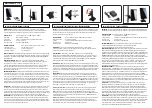
SXblue Series User Manual
87
In order to maintain a strategic advantage, the US DoD used to artificially degrade
the performance of the SPS so that the positioning accuracy was limited to 100
meters 95% of the time. This intentional degradation was called Selective
Availability (SA). The effect of SA has been turned to zero since mid-2000, and
has been officially ‘turned off’ since then (2007).
Currently, autonomous GPS is able to provide accuracy on the order of 10 meters,
depending on the sophistication of the GPS engine. For many positioning and
navigation applications, this level of accuracy is not sufficient, and differential
techniques must be employed.
Differential GPS
The primary sources of errors that degrade GPS performance include SA
(currently set to a zero effect), atmospheric errors, timing errors, satellite orbit
errors, and multipath. Differential GPS (DGPS) is essentially a differencing
process that removes sources of error from the GPS position solution and
improves the integrity of the GPS position solution. There are a number of methods
of differential measurement correction:
•
Conventional real-time differential – This is the most common form of correcting GPS errors
in real-time with corrections sent to the rover GPS receiver by some form of communications
equipment. Conventional real-time differential uses C/A code range measurements and their
associated corrections. Carrier phase corrections are not used with this form of differential
technique.
•
Post processing – This method is often used when either higher accuracy than achievable
through conventional differential is needed, or a conventional form of real-time corrections is
not available in the region where the rover receiver is being operated. Depending on receiver
hardware and the methodology used for post process, performance can be from many
centimeters to millimeter precision. A variety of 3
rd
party software packages are available to
post process GPS raw measurement data. The SXblue receiver can be configured to output
raw measurement data at rates of up to 20 Hz in a proprietary format. This data can be
converted to an industry standard RINEX format if needed.
•
Real-Time Kinematic – This method uses more sophisticated techniques to resolve the
number of wavelengths between the satellite and the user, to provide centimeter-level
positioning (or better) in real-time. This technique uses high-end receiver hardware,
antennas, and internal operating software to compute accurate position solutions. The
compromise with this method of differential correction is increased system complexity, cost,
and operating constraints.
The SXblue receiver includes a primary source of conventional real-time
corrections –Space-Based Augmentation System (SBAS). External corrections
may also be input to the SXblue receiver for situations where either internal
correction services is not available or an external source is preferential.
In addition to the conventional differential positioning with internal sources of
corrections, the SXblue receiver also has a documented binary raw measurement
protocol. A RINEX translator is available from SXblue GPS in the event that this
may be useful, in addition to some C code snippets to aid in integrating the binary
format itself into your own application.
Summary of Contents for iSXblue II+ GNSSTM
Page 1: ...USER MANUAL WWW SXBLUEGPS COM...
Page 74: ...SXblue Series User Manual 73...
Page 84: ...SXblue Series User Manual 83 Appendices...
Page 107: ...WWW SXBLUEGPS COM...
















































